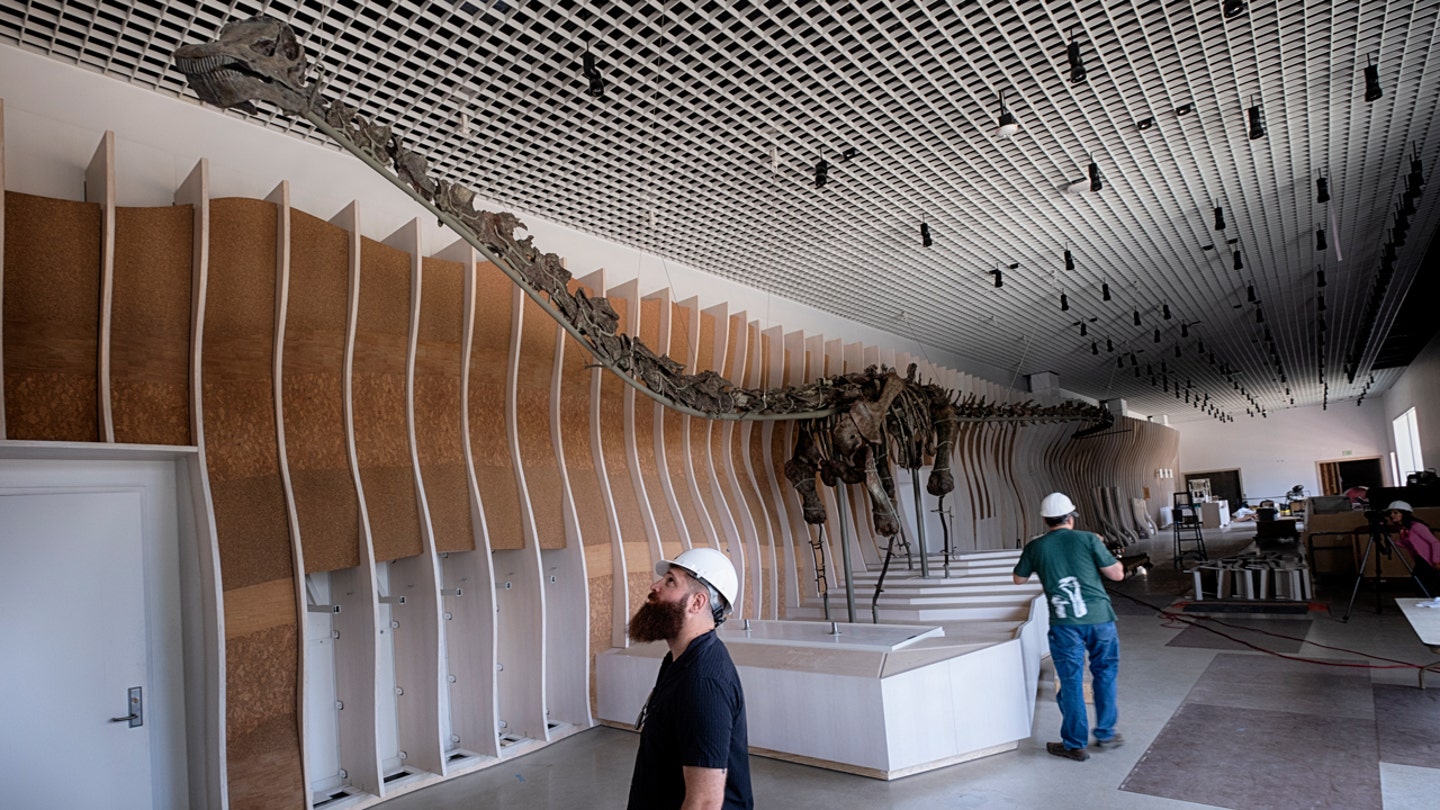- A newly discovered sauropod species is on display at the Natural History Museum in Los Angeles. His fossilized skeleton is the only one found on the planet whose bones are green, according to museum officials.
- Dinosaur fossils got their unique color from the mineral celadonite during the fossilization process.
- The dinosaur lived 150 million years ago in the late Jurassic period, making it older than Tyrannosaurus rex.
The latest dinosaur mounted at the Natural History Museum in Los Angeles isn’t just a member of a new species — it’s also the only one on the planet whose bones are green, according to museum officials.
Named “Gnatalie” (pronounced Natalie) for the mosquitoes that swarmed during the excavation, the fossils of the long-necked, long-tailed herbivorous dinosaur got its unique color, a dark mottled olive green, from the mineral celadonite during the fossilization process. .
While fossils are usually brown from silica or black from iron minerals, green is rare because celadonite forms under volcanic or hydrothermal conditions that usually destroy buried bones. Celadonite became fossilized when volcanic activity about 50 million to 80 million years ago made it hot enough to replace an earlier mineral.
NEW SPECIES OF DINOSAUR THAT LIVED 125 MILLION YEARS AGO, IDENTIFIED IN ENGLAND
The dinosaur lived 150 million years ago in the late Jurassic period, making it older than Tyrannosaurus rex – which lived 66 million to 68 million years ago.
Researchers discovered the remains in 2007 in the Utah Badlands.

A 150-million-year-old dinosaur skeleton is displayed at the Natural History Museum’s new welcome center, currently under construction, July 2, 2024, in Los Angeles. (AP Photo/Richard Vogel)
“Dinosaurs are a great tool to teach our visitors about the nature of science, and what better way to engage them in the process of scientific discovery and make them they reflect on the wonders of the world we live in!” Luis M. Chiappe of the museum’s Dinosaur Institute said in a statement about his team’s discovery.
Matt Wedel, an anatomist and paleontologist at Western University of Health Sciences in Pomona near Los Angeles, said he heard “rumors of a green dinosaur very early on when I was in graduate school.”

The skull of a 150-million-year-old dinosaur is displayed at the Natural History Museum’s new welcome center currently under construction on July 2, 2024, in Los Angeles. (AP Photo/Richard Vogel)
When he looked at the bones while they were still being cleaned, he said they were “like nothing else I’ve ever seen.”
The dinosaur is similar to a species of sauropod called Diplodocus and the discovery will be published in a scientific paper next year. The sauropod, referring to a massive herbivorous family that includes Brontosaurus and Brachiosaurus, will be the largest dinosaur at the museum and can be seen this fall in the new welcome center.

A 150-million-year-old dinosaur skeleton is displayed at the Natural History Museum’s new welcome center as a construction crew works on July 2, 2024 in Los Angeles. (AP Photo/Richard Vogel)
CLICK HERE TO GET THE FOX NEWS APP
John Whitlock, who teaches at Mount Aloysius College, a private Catholic college in Cresson, Pennsylvania, and researches sauropods, said it was exciting to have such a complete skeleton to help fill in the gaps for less well-known specimens. full.
“It’s huge, it really adds to our ability to understand taxonomic diversity … but also anatomical diversity,” Whitlock said.
The dinosaur was named “Gnatalie” last month after the museum asked for a public vote on five choices that included Verdi, a derivative of the Latin word for green; Olive, after the small green fruit that symbolizes peace, joy and strength in many cultures; Esme, short for Esmeralda, which is Spanish for Emerald; and Sage, a green and iconic LA plant also grown in the Natural History Museum’s Nature Gardens.